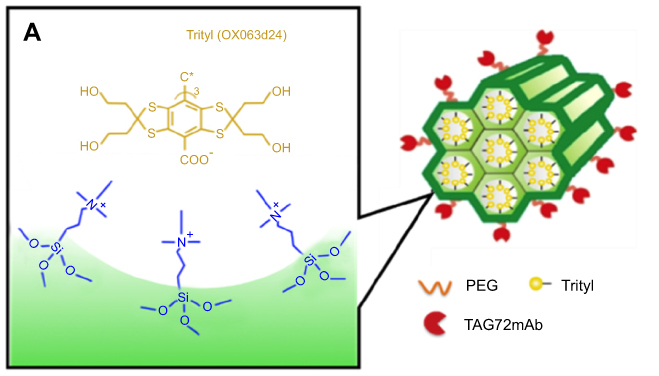June 25, 2019 | Jola Glotzer
Measuring oxygen levels in solid tumors
A UChicago team of Nai-Tzu Chen and Chin-Tu Chen contributes to the development of a novel technology allowing them to measure oxygen levels in solid tumors and thus help optimize cancer treatment
In 2015, Nai-Tzu Chen, a postdoc in Chin-Tu Chen’s lab at UChicago, received a CBC Postdoctoral Research Award (PDR) for the project “Highly Sensitive Nano-radicals for in vivo Tumor Oxygen Measurements Using Electron Paramagnetic Resonance Imaging (EPRI).” The CBC is proud to report that the team has recently published a paper in the International Journal of Nanomedicine, titled “Highly sensitive electron paramagnetic resonance nanoradicals for quantitative intracellular tumor oxymetric images,” which the authors attribute in part to the CBC PDR Award.
The paper describes the development of a new nanoplotform-based technology that employs fluorescein isothiocyanate-labeled mesoporous silica nanoparticles (FMSNs) as oxygen concentration-sensing trityl radical carriers. The new method appears highly sensitive and capable of quantitatively evaluating intracellular oxygen levels within a tumor in real-time. The rationale behind the development of this technology is that the more aggressive malignant tumors tend to contain low oxygen levels. Hence, being able to predict the tumor malignancy by measuring its oxygen concentration could be very useful in optimizing the cancer treatment of the patients.
Chin-Tu Chen is Associate Professor of Radiology and is affiliated with the Committee on Medical Physics and the College at UChicago. Besides winning the CBC PDR Award, Chen was also an invited speaker at the 6th Annual CBC Symposium (2008) and a member of the CBC Spark Review Panel during the time the program was active (2008-2011). The CBC congratulates all authors on the current study and thanks Dr. Chen for his time and support of CBC’s programming.
Publication attributed to CBC funding*:
Chen NT, Barth ED, Lee TH, Chen CT, Epel B, Halpern HJ, Lo LW. Highly sensitive electron paramagnetic resonance nanoradicals for quantitative intracellular tumor oxymetric images. Int J Nanomedicine. 2019 Apr 29;14:2963-2971. eCollection 2019. (PubMed)
ABSTRACT

Illustration of trityl-loaded FMSNs for electron paramagnetic resonance imaging. FMSN with targeting moiety, TAG72mAb, as a carrier for trityl radical for in vivo tumor oxygen measurement. (Source: IJN)
Purpose: Tumor oxygenation is a critical parameter influencing the efficacy of cancer therapy. Low levels of oxygen in solid tumor have been recognized as an indicator of malignant progression and metastasis, as well as poor response to chemo- and radiation therapy. Being able to measure oxygenation for an individual’s tumor would provide doctors with a valuable way of identifying optimal treatments for patients.
Methods: Electron paramagnetic resonance imaging (EPRI) in combination with an oxygen-measuring paramagnetic probe was performed to measure tumor oxygenation in vivo. Triarylmethyl (trityl) radical exhibits high specificity, sensitivity, and resolution for quantitative measurement of O2 concentration. However, its in vivo applications in previous studies have been limited by the required high dosage, its short half-life, and poor intracellular permeability. To address these limitations, we developed high-capacity nanoformulated radicals that employed fluorescein isothiocyanate-labeled mesoporous silica nanoparticles (FMSNs) as trityl radical carriers. The high surface area nanostructure and easy surface modification of physiochemical properties of FMSNs enable efficient targeted delivery of highly concentrated, nonself-quenched trityl radicals, protected from environmental degradation and dilution.
Results: We successfully designed and synthesized a tumor-targeted nanoplatform as a carrier for trityl. In addition, the nanoformulated trityl does not affect oxygen-sensing capacity by a self-relaxation or broadening effect. The FMSN-trityl exhibited high sensitivity/response to oxygen in the partial oxygen pressure range from 0 to 155 mmHg. Furthermore, MSN-trityl displayed outstanding intracellular oxygen mapping in both in vitro and in vivo animal studies.
Conclusion: The highly sensitive nanoformulated trityl spin probe can profile intracellular oxygen distributions of tumor in a real-time and quantitative manner using in vivo EPRI.
ACKNOWLEDGMENTS
This research was funded by BN-106-PP-04 (National Health Research Institutes, Taiwan), NSC100-2911-I-400-502, MOST 106-2113-M-039-002-MY2, MOST 107-2113-M-039-003-MY2 (Ministry of Science and Technology of Taiwan), CMU107-N-20 (China Medical University), PDR-075 (Chicago Biomedical Consortium), USA NIH P41 EB002034 and R01 CA098575.
Featured CBC Community member(s):
Chin-Tu Chen, UChicago
- *CBC Postdoctoral Research Award (2015):
▸ Highly Sensitive Nano-radicals for in vivo Tumor Oxygen Measurements Using Electron Paramagnetic Resonance Imaging (EPRI)
PIs: Nai-Tzu Chen (postdoc) and Chin-Tu Chen (UChicago) - 6th Annual CBC Symposium (2008):
▸ Frontiers in Molecular Imaging: from Promises to Practice
Chin-Tu Chen — Symposium Speaker - Spark Review Panel
Chin-Tu Chen — Spark Reviewer
ARTICLES PUBLISHED IN THE PAST ABOUT THE FEATURED CBC COMMUNITY MEMBER(S):

